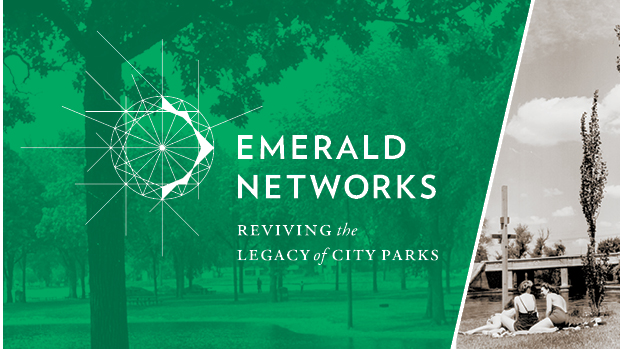Reviving the Legacy of City Parks

 Sasaki
Sasaki

It is time to begin another era of visionary parks. We must elevate the discussion of urban parks and understand their profound importance to our cities. Emerald Networks surveys a series of urban park systems—their plans, evolution, and current status—and highlights contemporary projects within those existing park systems. In addition to outlining the development of parks thinking in the United States over time, Emerald Networks also explores changes in the context for urban parks today.
This text originally appeared as the forward to the recently printed book, Emerald Networks: Reviving the Legacy of City Parks, an examination of historic parks systems across the United States. This book serves as the companion piece to an exhibit of the same name, curated by Sasaki designers for Northeastern University earlier this year.
The historic principles guiding these systems still provide a useful lens for examining parks. The idea of parks as the lungs of the city, providing access to clean air and sunlight, translates into today’s broader idea of parks as critical to public health, for exercise, stress relief, and contact with nature. Olmsted’s prophetic ideas of park utility—that “service must precede art”—are gaining traction in the 21st century as we think of parks in terms of their urban performance and their multi-layering of uses. Crucial to these earlier ideas is the systematic thinking about parks as connected circuits or green ribbons. While this approach is currently languishing, the connectivity for people, hydrology, and habitat is key to making parks effective and cities successful. The importance of parks in their expression of democratic ideals and their role as public space, from which no one is excluded, is of increasing significance in today’s more fragmented and diverse societies. Today there are also other concerns driving new thinking about parks. Economic issues loom large, both in terms of how to make parks economically sustainable and how they can be a part of strategies for economic development. In addition to being ecologically and socially sustainable, parks must be resilient to change of all kinds, since their use and programs will continue to develop over time. As infrastructure changes, opportunities for parks emerge and their role as green infrastructure becomes increasingly important. All of these approaches can serve to sharpen our thinking on how to advocate for better park systems.
We have to make urban parks and their urban agency central to people’s thinking about cities, urban revitalization, and resilience. Too often parks are perceived as a luxury that can be dealt with at some point in the future when everyone has jobs and housing. But a healthy city requires an integrated system of open space that addresses issues of public health, safety, and community resilience.
North American cities are confronted by a range of issues in which parks can play a vital role: collapsing, outdated infrastructure; deteriorating public health; social fragmentation; air, water, and climate issues; and so on. We now have more data on how park systems perform, and we have more understanding of the role of open space in cities, at a time when more value is being placed on increasing urban density.
We need to build from these historic park systems and learn from their legacy. They illustrate very clearly how important connectivity and access are to parks, and yet how difficult these are to achieve. This is the key issue that requires a broader urban vision.
By looking at a range of contemporary parks, Emerald Networks also allows us to think about what innovation looks like in park systems today. We can see how the implementation of sophisticated ecological ideas and new technology will be key in the future: we can manage parks as ongoing ecological systems rather that horticultural treasures—using perennial meadows instead of lawns, selecting diverse and resilient plantings, conserving water, and creating habitat. Parks can use the latest technology to manage water and energy use beyond park boundaries, and in smart operating systems. Creativity can also be applied to new funding mechanisms, creating green jobs and harnessing urban development to build investment in parks.
Visionary park plans should not be a thing of the past. Our cities need the kind of ambitious thinking that informed the creation of these historic parks. Let’s use investigations like Emerald Networks as the foundation for a new public discourse that propels park systems into the center of our thinking about city futures.
Click here to view a digital copy of “Emerald Networks: Reviving the Legacy of City Parks”